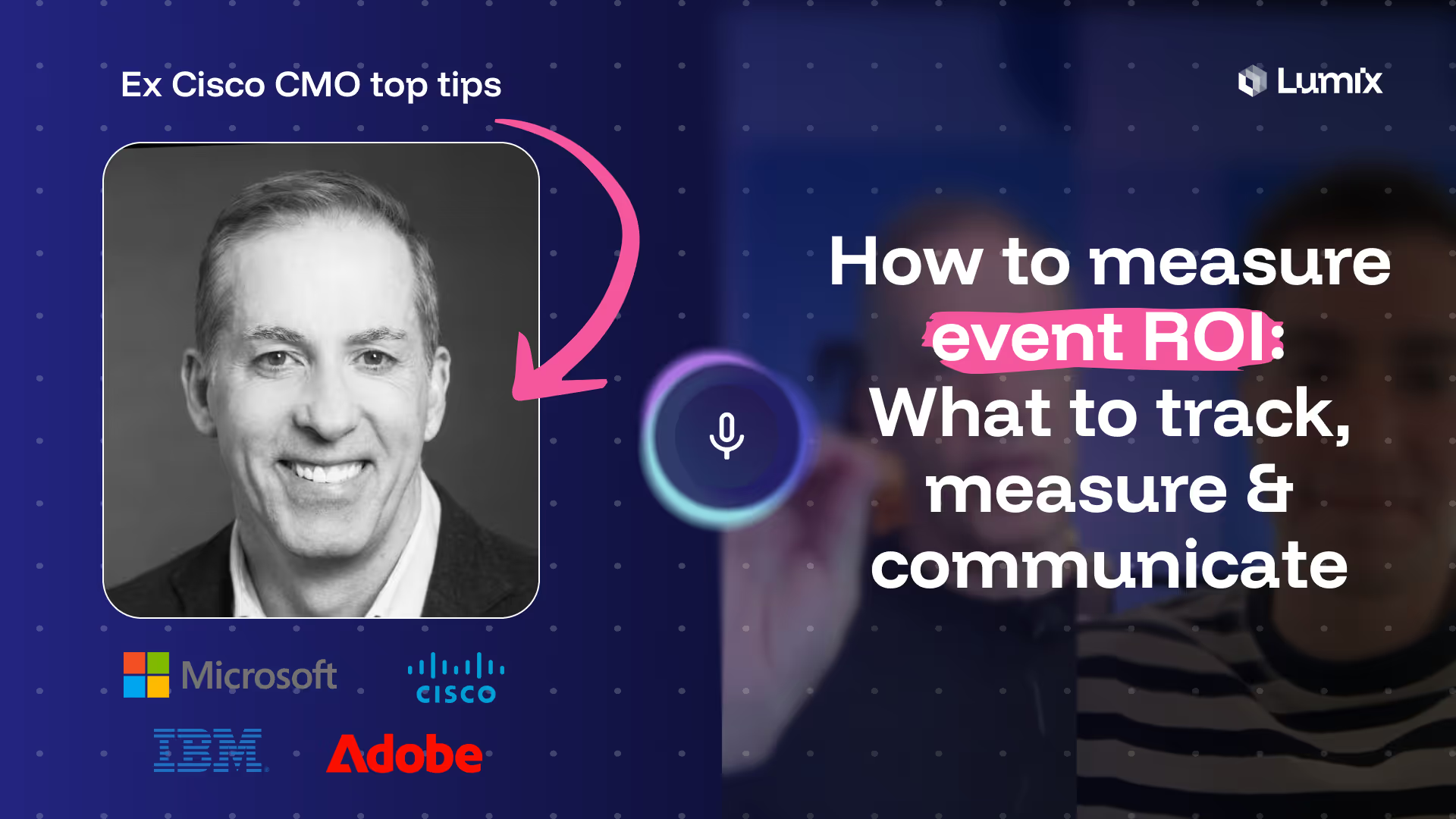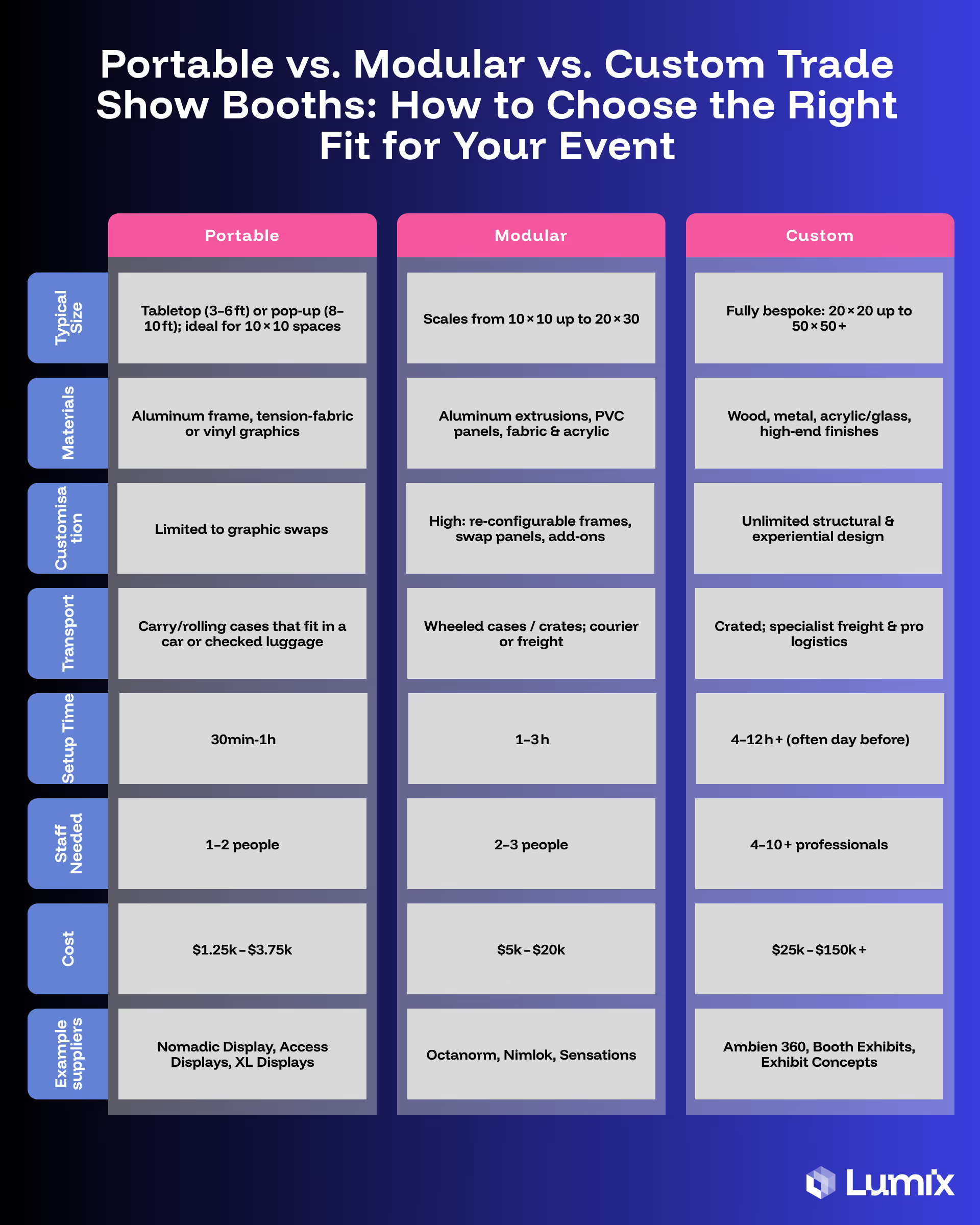Proving Event ROI: How to Speak Finance’s Language with Insights from Mark Phibbs, ex-Adobe & Cisco CMO

Weekly newsletter
You’re leading the charge on your company’s biggest event of the year. The booth is booked, the speaker lineup is solid, and your team is in full swing. But just as things are picking up, a message lands in your inbox from your favourite CFO:
“Can we revisit the numbers? We need to be sure this spend ties back to revenue.”
It’s the question every marketer knows is coming and often dreads. Events are one of the most powerful plays in a marketer’s toolkit, but they remain one of the toughest to justify on a balance sheet. Nearly 30% of organisers manage event budgets between £1M and £2M, and with that level of investment, finance and leadership expect more than impressions or booth traffic. They want measurable, attributable return. As Mark Phibbs, former VP Marketing at Cisco and Adobe and now CMO Advisor to Lumix, told us on our recent podcast:
“Events have always been central to building pipeline and community, but they’re only effective when marketing and finance can see the same numbers.”
The problem is, fragmented suppliers, rising costs, and post-event ambiguity make that clarity difficult. Even the most experienced marketing and finance leaders are often left questioning what the event actually delivered and whether the investment truly paid off.
At Lumix, we’ve worked with global brands and event leaders who face that exact pressure. In this guide, with Mark’s perspective woven in, we’ll show you how to measure event ROI, avoid common pitfalls, and turn your results into a story leadership can trust. You can watch our full conversation with Mark below:
Rethinking ROI: Beyond Leads and Logos
ROI isn’t a new concept, but in event marketing, it’s often oversimplified. Too many wrap-up decks still lead with booth traffic or social buzz, but rarely prove commercial value. Mark puts it simply:
“ROI isn’t about counting heads at a booth — it’s about understanding how events accelerate pipeline, deepen relationships, and build brand loyalty. If it’s not tied to one of those, it’s not ROI.”
True event ROI begins by defining “return” beyond the obvious. Consider the full range of outcomes that matter to your business:
- Revenue: Pipeline generated, deals influenced, accounts moved forward, revenue closed.
- Efficiency: Cost savings from smarter supplier choices, consolidated workflows, or reduced agency markups.
- Experience: Brand lift, executive access, content creation, and stronger customer engagement.
The formula stays the same, (Return – Investment) / Investment, but the inputs must reflect what matters most to your strategy. The most effective teams define this during planning, not post-event, so ROI reporting doesn’t rely on guesswork or gut feel.
Models for Calculating ROI
For 95% of event teams, proving ROI is the top priority, yet 38% still struggle to do it especially in complex B2B environments. The challenge isn’t just math, it’s choosing a model that reflects the purpose of your event. As Mark shared, “The CFO’s language is pipeline. Show how the event created or accelerated it, that’s when finance starts to listen.” Before you apply any model, you need a robust way to capture and store event attendance data against contacts in your CRM. That means setting up custom activities, events, or objects that track:
- Who attended (and how often)
- What sessions they engaged with
- How that correlates with future pipeline or closed revenue
Tools like HubSpot and Salesforce have native frameworks for this — or you can build custom workflows using event management platforms like Cvent or Bizzabo to sync attendance data automatically. Once your data foundation is set, you can layer in one of these models:
1. Simple Return Model
(Return – Investment) / Investment
The most straightforward approach, ideal for summarising high-level performance, particularly for leadership reviews.
When to use: Ticketed workshops, paid-entry conferences, lead-gen expos.
Pros:
- Easy to calculate and communicate
- Works for events with binary outcomes (profit or loss)
Cons:
- Misses brand and relationship impact
- Not suitable for long-cycle B2B sales
Mark adds: “You can’t judge an event’s success by attendance alone. You have to show how it moved the business forward.”
2. Incremental Revenue Model
(Gross Revenue Attributed to Event – Event Cost) / Event Cost
This model isolates revenue caused by the event - new pipeline, reactivated accounts, or accelerated deals.
When to use: Executive dinners, field activations, client summits.
Pros:
- Connects spend directly to sales outcomes
- Perfect for smaller, high-impact formats
Cons:
- Relies on precise CRM attribution
- Requires pre-event baselines
3. Return/Investment Ratio
Event Revenue / Event Expenses
A simple ratio showing how many pounds (or dollars) were generated for each one spent.
When to use: Sponsorship-heavy expos, product showcases, high-volume trade fairs.
Pros:
- Simple and scalable across events
- Ideal for benchmarking across time periods
Cons:
- Lacks context on margin and long-term value
4. Multi-Touch Attribution
This model acknowledges that no sale comes from a single channel. It assigns value across every interaction, from digital touchpoints to in-person events, giving you a complete picture of influence. “At Cisco, we found that attending an event was one of the strongest predictors of purchase intent,” Mark explained. “That’s why it deserves a weighting in any attribution model.” Modern marketers can now build this using open-source econometric tools like Google’s Lightweight MMM, making advanced attribution more accessible than ever. Our advice here is to set aside your part of your marketing budget for measurement - be that in the form of an agency or external tool to help you achieve this or via hiring data analysts and engineers into your team. At least 5-10% of your budget needs to be set aside for this.
5. Return on Objective (ROO)
Not all events are about revenue today, some are about reputation, relationships, or reach. ROO focuses on strategic goals such as engagement, brand perception, or partnership depth.
When to use: Leadership forums, press launches, community meet ups.
Pros:
- Recognises long-term, non-financial value
- Aligns events with brand and advocacy goals
Cons:
- Requires clear, pre-agreed KPIs
- Harder to translate into financial terms
6. A Holistic Approach
Sometimes, the most credible proof comes from comparison, not calculation. A geo-uplift study, targeting one region with events and another without can show tangible differences in pipeline and revenue over time. It’s simple, testable, and CFO-friendly but you will need a certain level of commitment and spend to prove the value and you will need to keep an eye on other channel activity in that region to know what's making an impact.
Building a Smarter ROI Model: What to Count In and What Not to Miss
Mark’s golden rule:
“You can’t retrofit ROI after the event. You have to plan for it before.”
A credible ROI story starts with structure. You need to know what to track, why it matters, and how it ties to real business outcomes.
What to Include on the Value Side
If you’re only counting closed deals, you’re missing most of the picture. Effective ROI models measure both immediate and long-term value:
- Pipeline and Deal Progression: Track how opportunities moved after the event. Did strategic accounts re-engage? Did deals accelerate?
- Revenue-driving Activities: Include all income — ticket sales, on-site purchases, sponsorship fees, and partnership deals.
- Brand Reach and Perception: Measure earned media, session attendance, and sentiment.
- Audience Quality and Network Growth: Segment attendees by ICP fit and seniority.
- Content and Campaign Assets: Treat your event as a content factory — video, testimonials, clips, quotes, and materials that fuel marketing for months.
What to Account for on the Cost Side
Events rarely go over budget because of the big costs; it’s the hidden inefficiencies that drain ROI.
- Operational Inefficiencies: Duplicated vendor work, manual coordination, and poor visibility between teams.
- Supplier Waste: Late fees, scope creep, and unplanned add-ons.
- Opportunity Cost of Time: Internal hours spent chasing logistics instead of strategy or content.
“Time is money,” says Mark. “If your team is deep in manual logistics instead of driving engagement, that’s a cost, even if it’s not on the balance sheet.” At Lumix, we’ve seen teams reclaim up to 30% of total event spend by tightening supplier management and centralising procurement. Our platform exists to eliminate that waste and redirect spend where it creates the most value, experience and engagement.
Event Technology That Supports Real ROI Measurement
Even the best models fail without the right systems underneath. “The best-run events I’ve seen,” Mark shared, “were the ones where marketing, sales, and finance were all looking at the same dashboard.” That’s why technology is as crucial as the metrics themselves.
The Bottom Line
Events demand time, budget, and collaboration. Done right, they create commercial momentum that drives both pipeline and brand love — but proving that impact requires more than a great on-site experience. As Mark summarised perfectly:
“The goal isn’t to prove that events matter. It’s to prove how much they matter — in the same language finance understands.”
At Lumix, we bring clarity to that conversation. Our platform streamlines supplier sourcing, spend visibility, and operational control so you can focus on delivering meaningful outcomes — not chasing numbers.
Connect with the Lumix team to learn how you can simplify costs, measure ROI more clearly, and turn every event into a proven business driver.
Lumix Blogs
Get the indise scoop: the latest tips, tricks, & product updates

In House Vs Agency. Which Should You Choose To Manage Events
Compare in house vs agency event management models. Understand the trade-offs in cost, control, ROI and explore where a hybrid approach fits best.

Portable vs Modular vs Custom Trade Show Booths: How to Choose the Right Fit for Your Event
Understand which booth set up is right for your next event
Frequently Asked Question
Have another question? Please contact our team!
Yes. The platform provides side-by-side quote comparisons that show what’s included (and what isn’t) in each proposal. You’ll see cost breakdowns, supplier notes, and Lumix’s benchmarked pricing insights all designed to help you make confident, data-driven decisions.
Yes. You can upload and store your existing brief templates, or use Lumix’s AI-assisted builder to generate new ones. The platform also learns from your past events, so future briefs can be created faster with pre-filled details and preferred suppliers.
Absolutely. Lumix is built for flexibility. You can update or amend briefs at any time through quote revisions. When you make changes, suppliers are automatically notified and can adjust their quotes accordingly, keeping everything transparent and version-controlled.
A Lumix-vetted supplier has been verified for legal identity, financial health, insurance, certifications, and recent performance. We don’t just check paperwork once — we continuously monitor suppliers’ live performance on the platform to ensure they meet professional, safety, and compliance standards.
Our vetting process happens in three levels: Verified: Baseline identity and compliance checks, legal registration, sanctions screening, insurance, and minimum financial health scores. Certified: Category-specific evidence such as food-hygiene, rigging, or data-security certifications, depending on the supplier’s role. Audited: For high-value or critical suppliers, we add deeper due diligence including third-party audits, ESG assessment, and verified delivery KPIs on Lumix.
Yes. We align our vetting standards with leading UK and global frameworks such as Achilles, Hellios FSQS/JOSCAR, Avetta, SafeContractor, and EcoVadis. Where appropriate, Lumix integrates or recognises these certifications within our supplier profiles to avoid duplicate checks.

